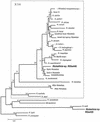Detection of Ehrlichia spp., Anaplasma spp., Rickettsia spp., and other eubacteria in ticks from the Thai-Myanmar border and Vietnam
- PMID: 12682151
- PMCID: PMC153861
- DOI: 10.1128/JCM.41.4.1600-1608.2003
Detection of Ehrlichia spp., Anaplasma spp., Rickettsia spp., and other eubacteria in ticks from the Thai-Myanmar border and Vietnam
Abstract
A total of 650 ticks, including 13 species from five genera, were collected from animals, from people, or by flagging of the vegetation at sites on the Thai-Myanmar border and in Vietnam. They were tested by PCR to detect DNA of bacteria of the order RICKETTSIALES: Three Anaplasma spp. were detected in ticks collected in Thailand, including (i) Anaplasma sp. strain AnDa465, which was considered a genotype of Anaplasma platys (formerly Ehrlichia platys) and which was obtained from Dermacentor auratus ticks collected from dogs; (ii) Anaplasma sp. strain AnAj360, which was obtained from Amblyomma javanense ticks collected on a pangolin; and (iii) Anaplasma sp. strain AnHl446, which was closely related to Anaplasma bovis and which was detected in Haemaphysalis lagrangei ticks collected from a bear. Three Ehrlichia spp. were identified, including (i) Ehrlichia sp. strain EBm52, which was obtained from Boophilus microplus ticks collected from cattle from Thailand; (ii) Ehrlichia sp. strain EHh324, which was closely related to Ehrlichia chaffeensis and which was detected in Haemaphysalis hystricis ticks collected from wild pigs in Vietnam; and (iii) Ehrlichia sp. strain EHh317, which was closely related to Ehrlichia sp. strain EBm52 and which was also detected in H. hystricis ticks collected from wild pigs in Vietnam. Two Rickettsia spp. were detected in Thailand, including (i) Rickettsia sp. strain RDla420, which was detected in Dermacentor auratus ticks collected from a bear, and (ii) Rickettsia sp. strain RDla440, which was identified from two pools of Dermacentor larvae collected from a wild pig nest. Finally, two bacteria named Eubacterium sp. strain Hw124 and Eubacterium sp. strain Hw191 were identified in Haemaphysalis wellingtoni ticks collected from chicken in Thailand; these strains could belong to a new group of bacteria.
Figures



References
-
- Dumler, J. S., A. F. Barbet, C. P. Bekker, G. A. Dasch, G. H. Palmer, S. C. Ray, Y. Rikihisa, and F. R. Rurangirwa. 2001. Reorganization of genera in the families Rickettsiaceae and Anaplasmataceae in the order Rickettsiales: unification of some species of Ehrlichia with Anaplasma, Cowdria with Ehrlichia and Ehrlichia with Neorickettsia, descriptions of six new species combinations and designation of Ehrlichia equi and ′HGE agent' as subjective synonyms of Ehrlichia phagocytophila. Int. J. Syst. E vol. Microbiol. 51:2145-2165. - PubMed
-
- Dumler, J. S., and D. Walker. 2001. Human ehrlichioses. Lancet Infect. Dis. 2001:21-28.
Publication types
MeSH terms
Substances
Associated data
- Actions
- Actions
- Actions
- Actions
- Actions
- Actions
- Actions
- Actions
- Actions
- Actions
Grants and funding
LinkOut - more resources
Full Text Sources
Molecular Biology Databases
Miscellaneous

